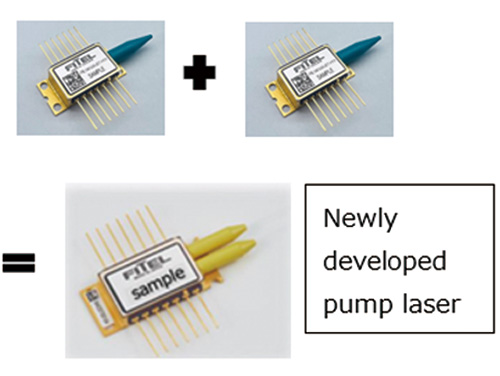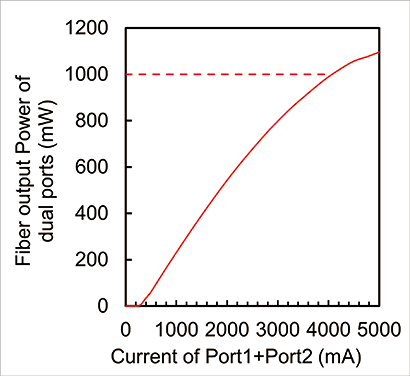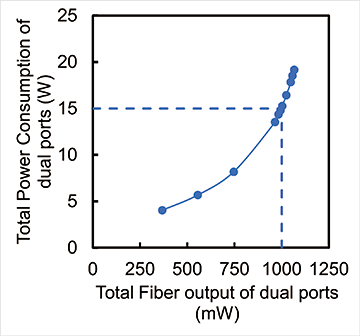Development of a high output, low power consumption, small S-,C-,L-band dual port pump laser for Raman amplifiers
- Contributing to downsizing the Raman amplifier unit through the development of pump lasers with smaller space requirements -
- Developed a dual port pump laser for Raman amplifiers that has two optical output ports in the existing 14 pin butterfly package
- Contributing to reducing the Raman amplifier and overall system size through a high output pump laser with small space requirements
Furukawa Electric Co., Ltd. (Head Office: 2-6-4 Otemachi, Chiyoda-ku, Tokyo; President: Hideya Moridaira) developed a small S-,C-,L-band dual port pump laser for Raman amplifiers that has high output and low power consumption.
Background
As data transmission speed increases, the transmission distance decreases due to degradation of the OSNR (note 1) on the signal receiving side. In particular, when existing communication systems are used at faster transmission speeds, the role of the Raman amplifier, which can amplify optical output power without attenuation of the signal light quality, will become more important. Also, because the bandwidth of the signal expands as a result of high-speed transmission, it is necessary to extend the bandwidth in order to enable high volume transmission. Thus, Raman amplifiers need to have high flexibility to amplify the light source at a discretionary range based on the selection of the pump laser wavelength. On the other hand, with consideration for the expansion into the S-, C-, L-band in the future, the number of pump lasers used will increase, so it will be more important for them to have small size platform, high output power and low power consumption.
Details
In October 2022, Furukawa Electric achieved 800mW output in the C-band, and also expanded the lineup to include a 700mW pump laser for the S-band and low power consumption 500mW pump laser for the L-band. Product sample shipments of these pump lasers began in April. Through the commercialization of the FRL1441U Series, we have reduced the power consumption of the pump lasers used for existing Raman amplifiers in the S-,C-,L-band by 37% and made it possible to reduce the space used by using only 1 pump laser instead of the previous 2 units. The current new development pursues further space saving through a dual port pump laser for Raman amplifiers that has 2 optical output ports within the existing 14 pin butterfly package.
The module concept is shown in Fig. 1. Two different semiconductor laser chips are equipped in a 14 pin butterfly package, and the light is coupled in the optical fiber using optical coupling technology.
In the operating current-output power curve (laser temperature of 35℃, Fig. 2) of a prototype equipped with 500mW chips from the leading FOL1439R Series, the horizontal axis shows total operating current by both ports and the vertical axis shows total fiber output of both ports. As a result, it was confirmed that an output of 1W, which is the combined output of the two 500mW FOL1439R Series pump lasers, was achieved from a single dual port pump laser. Also, total operating current at a combined output of 1W (laser temperature of 35℃ and case temperature of 70℃) was 15W (Fig. 3). This is equivalent to 7.5W per port, which is roughly the same power consumption as the 500mW FOL1439R Series pump laser. Going forward, with the aim of achieving higher output and lower power consumption, we will work to further enhance the performance of this pump laser through the development of laser chips with even higher output and lower power consumption.
The newly developed dual port pump laser for Raman amplifiers (patented) uses our high accuracy fiber coupling technology and optical semiconductor processing technology using InP (note 2) semiconductor materials developed over the past 25 years, as well as the application of our unique low loss, high efficiency semiconductor laser chip structure. The small size of the newly developed high output pump laser will make it possible to downsize the Raman amplifier unit. This downsizing will also lead to the use of fewer components, thus contributing to smaller overall system size.
Product samples will begin shipping from July 2024 with mass production planned to commence from a half year of 2025.
An oral presentation for this product will be given on the first day of ECOC2023 scheduled to be held in Glasgow, Scotland in October (ECOC2023 homepage: https://ecoc2023.theiet.org/).
The current development was conducted and achieved as part of the National Institute of Information and Communications Technology (NICT) commissioned research “Beyond 5G – Development of extended range optical node technology for realizing ultra-high speed, large volume networks” (Key Issue 045).
Going forward, we will continue to develop high output, low power consumption laser chip technology and contribute to accelerated reductions in module power consumption and the establishment of environmentally-friendly networks.
(note 1)OSNR (Optical Signal to Noise Ratio): Parameter that indicates the signal-to-noise ratio
(note 2)InP (Indium Phosphide): A III-V compound semiconductor that is used for the manufacture of laser diode chips and high speed transistors
Related News Release
Furukawa Electric Group’s efforts towards the SDGs
Based on the “Sustainable Development Goals (SDGs)” adopted by the United Nations, Furukawa Electric Group has formulated the “Furukawa Electric Group Vision 2030” which sets the year 2030 as its target and is advancing efforts with the aim to “Build a sustainable world and make people’s life safe, peaceful and rewarding, Furukawa Electric Group will create solutions for the new generation of global infrastructure combining information, energy and mobility.” Toward the achievement of our Vision 2030, we will take open, agile, and innovative approaches to promote ESG management that aims to increase corporate value over the medium to long term and will contribute to the achievement of the SDGs.










 Share
Share Tweet
Tweet Share
Share